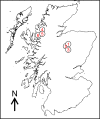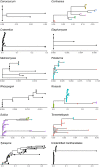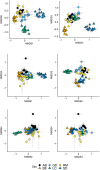Location, but not defensive genotype, determines ectomycorrhizal community composition in Scots pine (Pinus sylvestris L.) seedlings
- PMID: 33976851
- PMCID: PMC8093658
- DOI: 10.1002/ece3.7384
Location, but not defensive genotype, determines ectomycorrhizal community composition in Scots pine (Pinus sylvestris L.) seedlings
Abstract
For successful colonization of host roots, ectomycorrhizal (EM) fungi must overcome host defense systems, and defensive phenotypes have previously been shown to affect the community composition of EM fungi associated with hosts. Secondary metabolites, such as terpenes, form a core part of these defense systems, but it is not yet understood whether variation in these constitutive defenses can result in variation in the colonization of hosts by specific fungal species.We planted seedlings from twelve maternal families of Scots pine (Pinus sylvestris) of known terpene genotype reciprocally in the field in each of six sites. After 3 months, we characterized the mycorrhizal fungal community of each seedling using a combination of morphological categorization and molecular barcoding, and assessed the terpene chemodiversity for a subset of the seedlings. We examined whether parental genotype or terpene chemodiversity affected the diversity or composition of a seedling's mycorrhizal community.While we found that terpene chemodiversity was highly heritable, we found no evidence that parental defensive genotype or a seedling's terpene chemodiversity affected associations with EM fungi. Instead, we found that the location of seedlings, both within and among sites, was the only determinant of the diversity and makeup of EM communities.These results show that while EM community composition varies within Scotland at both large and small scales, variation in constitutive defensive compounds does not determine the EM communities of closely cohabiting pine seedlings. Patchy distributions of EM fungi at small scales may render any genetic variation in associations with different species unrealizable in field conditions. The case for selection on traits mediating associations with specific fungal species may thus be overstated, at least in seedlings.
Keywords: Scots pine (Pinus sylvestris); community composition; ectomycorrhizal fungi; evolution; mutualism; secondary metabolites.
© 2021 The Authors. Ecology and Evolution published by John Wiley & Sons Ltd.
Conflict of interest statement
The authors have no conflicts of interest to declare.
Figures







Similar articles
-
Heritable genetic variation but no local adaptation in a pine-ectomycorrhizal interaction.Mycorrhiza. 2020 May;30(2-3):185-195. doi: 10.1007/s00572-020-00941-3. Epub 2020 Feb 20. Mycorrhiza. 2020. PMID: 32078050 Free PMC article.
-
Reciprocal interactions between Scots pine and soil food web structure in the presence and absence of ectomycorrhiza.Oecologia. 2000 Oct;125(1):109-118. doi: 10.1007/PL00008881. Oecologia. 2000. PMID: 28308212
-
Temporal approach to identifying ectomycorrhizal community associated with Mongolian pine in a desert environment, northern China.Microbiol Spectr. 2023 Sep 14;11(5):e0202623. doi: 10.1128/spectrum.02026-23. Online ahead of print. Microbiol Spectr. 2023. PMID: 37707453 Free PMC article.
-
Shift in ectomycorrhizal community composition in Scots pine (Pinus sylvestris L.) seedling roots as a response to nickel deposition and removal of lichen cover.Environ Pollut. 2002;120(3):797-803. doi: 10.1016/s0269-7491(02)00168-9. Environ Pollut. 2002. PMID: 12442803
-
Ectomycorrhizal fungal species differentially affect the induced defensive chemistry of lodgepole pine.Oecologia. 2018 Oct;188(2):395-404. doi: 10.1007/s00442-018-4231-2. Epub 2018 Jul 21. Oecologia. 2018. PMID: 30032438
Cited by
-
Ectomycorrhizal fungal communities of Swiss stone pine (Pinus cembra) depend on climate and tree age in natural forests of the Alps.Plant Soil. 2024;502(1-2):167-180. doi: 10.1007/s11104-022-05497-z. Epub 2022 May 26. Plant Soil. 2024. PMID: 39323574 Free PMC article.
References
-
- Agerer, R. (2001). Exploration types of ectomycorrhizae. Mycorrhiza, 11, 107–114. 10.1007/s005720100108 - DOI
-
- Anderson, I. C. , Chambers, S. M. , & Cairney, J. W. G. (2001). Distribution and persistence of Australian Pisolithus species genets at native sclerophyll forest field sites. Mycological Research, 105, 971–976. 10.1016/S0953-7562(08)61954-1 - DOI
-
- Baier, R. , Ingenhaag, J. , Blaschke, H. , Göttlein, A. , & Agerer, R. (2006). Vertical distribution of an ectomycorrhizal community in upper soil horizons of a young Norway spruce (Picea abies [L.] Karst.) stand of the Bavarian Limestone Alps. Mycorrhiza, 16, 197–206. 10.1007/s00572-006-0035-z - DOI - PubMed
Associated data
LinkOut - more resources
Full Text Sources
Other Literature Sources

